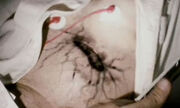No edit summary Tag: apiedit |
m (Reverted edits by Lionelfan123 (talk) to last version by BlueFrackle) |
||
| (8 intermediate revisions by 7 users not shown) | |||
| Line 23: | Line 23: | ||
In the light these creatures remain dormant; this allows for the possibility that they gain energy through photosynthesis. Considering the lack of resources the moon has to support life this large, this is plausible. They will not move or squirm even when being handled and relocated; a few were brought onto the lander as 'samples' and didn't shed their disguise until significantly later. When the sun vanishes, however, they become active. The freezing temperatures of the moon at night likely inspire the arthropods to seek warmer spots. |
In the light these creatures remain dormant; this allows for the possibility that they gain energy through photosynthesis. Considering the lack of resources the moon has to support life this large, this is plausible. They will not move or squirm even when being handled and relocated; a few were brought onto the lander as 'samples' and didn't shed their disguise until significantly later. When the sun vanishes, however, they become active. The freezing temperatures of the moon at night likely inspire the arthropods to seek warmer spots. |
||
| − | Smaller (perhaps juvenile) members of the species have been shown to burrow through flesh and become parasitic. It is interesting to note that this particular method of parasitic relationship is exceptionally crude and implies that the creatures do not have much experience attacking warm-blooded prey. The bodies of the Russian cosmonauts were severely |
+ | Smaller (perhaps juvenile) members of the species have been shown to burrow through flesh and become parasitic. It is interesting to note that this particular method of parasitic relationship is exceptionally crude and implies that the creatures do not have much experience attacking warm-blooded prey. The bodies of the Russian cosmonauts were severely desiccated, perhaps indicating that the creatures feed on fluids. This would explain the juvenile burrowing, as young require more food and warmth than matured individuals. It is likely that the mothers carry their young beneath their carapaces and so the juveniles may have confused a human body for their own mother's and made a home in it. Sometimes they will form colonies in impact craters where, in the dark, they can move around freely even during daytime hours. |
[[Category:Predators]] |
[[Category:Predators]] |
||
[[Category:Luna Wildlife]] |
[[Category:Luna Wildlife]] |
||
| Line 30: | Line 30: | ||
[[Category:Apollo 18 Universe]] |
[[Category:Apollo 18 Universe]] |
||
[[Category:Live Action Species]] |
[[Category:Live Action Species]] |
||
| + | [[Category:Creatures of unknown origin]] |
||
| + | [[Category:Venomous Species]] |
||
Revision as of 15:48, 3 July 2019
These arthropodic creatures are a deadly species native to Earth's moon. In a resting state they appear indistinguishable from rocks; they also carry a powerful venom which induces psychosis and violent aggression in humans.
Behavior and Anatomy
When not moving, the carapaces of these crab-like creatures disguise them as rocks. When mobile or hunting, they utilize six spidery legs and two large pincers by extending them through this outer shell. Sizes vary from small boulders to stones big enough to fit in one's hand, or even bigger to carry on a person. This camouflage mechanism is curious, as it implies the creatures either needed it to hunt or hide from larger predators. However, there is no other life on the moon to speak of, nor is there in our solar system as we understand it. This perhaps indicates that they did not originate on Earth's moon or that there are other creatures on Luna that were not revealed or chose not to reveal themselves to the crew of the Apollo 18.
The creatures carry a highly potent venom which they inject when biting. Symptoms of this poison include: blackening of the veins around the bite area (possibly necrosis), bloodshot eyes, antisocial behavior, and finally violent psychosis. It is unknown but highly likely that the venom is fatal, as there are only two known victims of it; one died when his space helmet was broken, the other was killed by the creatures. Inconclusive, but the rabid behavior induced by the venom indicates that it was likely a neurotoxin and would have caused brain and vital organ damage after prolonged exposure.

A wound infected by the Rock Alien infection
In the light these creatures remain dormant; this allows for the possibility that they gain energy through photosynthesis. Considering the lack of resources the moon has to support life this large, this is plausible. They will not move or squirm even when being handled and relocated; a few were brought onto the lander as 'samples' and didn't shed their disguise until significantly later. When the sun vanishes, however, they become active. The freezing temperatures of the moon at night likely inspire the arthropods to seek warmer spots.
Smaller (perhaps juvenile) members of the species have been shown to burrow through flesh and become parasitic. It is interesting to note that this particular method of parasitic relationship is exceptionally crude and implies that the creatures do not have much experience attacking warm-blooded prey. The bodies of the Russian cosmonauts were severely desiccated, perhaps indicating that the creatures feed on fluids. This would explain the juvenile burrowing, as young require more food and warmth than matured individuals. It is likely that the mothers carry their young beneath their carapaces and so the juveniles may have confused a human body for their own mother's and made a home in it. Sometimes they will form colonies in impact craters where, in the dark, they can move around freely even during daytime hours.